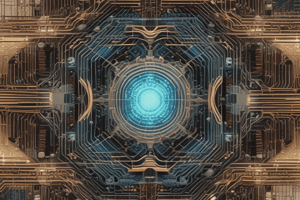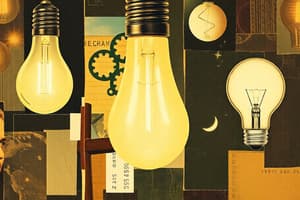Podcast
Questions and Answers
What process describes how light is emitted from an LED?
What process describes how light is emitted from an LED?
- Thermoluminescence
- Electroluminescence (correct)
- Photoelectric effect
- Photoconductivity
What is the primary factor that determines the color of light emitted by an LED?
What is the primary factor that determines the color of light emitted by an LED?
- The amount of current applied
- The temperature of the diode
- The size of the LED
- The energy gap of the semiconductor (correct)
Which of the following is NOT an advantage of LEDs over incandescent light sources?
Which of the following is NOT an advantage of LEDs over incandescent light sources?
- Higher heat generation (correct)
- Greater durability and reliability
- Lower energy consumption
- Longer lifetime
In which type of material are holes typically found in an LED?
In which type of material are holes typically found in an LED?
What characterizes the wavelength of emitted light from an LED?
What characterizes the wavelength of emitted light from an LED?
What is typically true about the light emission of LEDs?
What is typically true about the light emission of LEDs?
What is the approximate peak wavelength of a green LED?
What is the approximate peak wavelength of a green LED?
How do LED brightness levels vary?
How do LED brightness levels vary?
What is the relationship between forward current and power of light output in an LED?
What is the relationship between forward current and power of light output in an LED?
What happens to the radiation pattern of an LED as the viewing angle narrows?
What happens to the radiation pattern of an LED as the viewing angle narrows?
If an LED has a forward voltage drop of 2.2 V and the supply voltage is 5.0 V, what series resistor is needed to limit the current to 20 mA?
If an LED has a forward voltage drop of 2.2 V and the supply voltage is 5.0 V, what series resistor is needed to limit the current to 20 mA?
What is the power dissipated by an LED with a forward voltage drop of 2.2 V at 20 mA?
What is the power dissipated by an LED with a forward voltage drop of 2.2 V at 20 mA?
Which of the following is a common application of LEDs?
Which of the following is a common application of LEDs?
In a remote control, what type of LED is commonly used?
In a remote control, what type of LED is commonly used?
How is the power dissipated by an LED calculated?
How is the power dissipated by an LED calculated?
What occurs when multiple LED segments are forward biased in a seven-segment display?
What occurs when multiple LED segments are forward biased in a seven-segment display?
Flashcards
LED
LED
A semiconductor diode that emits light when forward-biased. Electrons recombine with holes in the p-type material, releasing energy as photons.
Electroluminescence
Electroluminescence
The emission of light from a material when an electric current is passed through it.
What determines the color of light emitted by an LED?
What determines the color of light emitted by an LED?
The energy gap of the semiconductor material used. The wider the gap, the higher the energy of the emitted photons, resulting in bluer light.
Advantages of LEDs over incandescent bulbs
Advantages of LEDs over incandescent bulbs
Signup and view all the flashcards
What is the purpose of the lens in an LED?
What is the purpose of the lens in an LED?
Signup and view all the flashcards
How does the forward current affect an LED's light output?
How does the forward current affect an LED's light output?
Signup and view all the flashcards
What is the wavelength of an LED?
What is the wavelength of an LED?
Signup and view all the flashcards
What are the typical uses of LEDs?
What are the typical uses of LEDs?
Signup and view all the flashcards
LED Spectral Output Curve
LED Spectral Output Curve
Signup and view all the flashcards
V-I Characteristic Curve (LED)
V-I Characteristic Curve (LED)
Signup and view all the flashcards
LED Radiation Pattern
LED Radiation Pattern
Signup and view all the flashcards
Forward Voltage Drop (LED)
Forward Voltage Drop (LED)
Signup and view all the flashcards
Maximum Current (LED)
Maximum Current (LED)
Signup and view all the flashcards
Power Dissipation (LED)
Power Dissipation (LED)
Signup and view all the flashcards
7-Segment LED Display
7-Segment LED Display
Signup and view all the flashcards
Infrared LED (Remote Control)
Infrared LED (Remote Control)
Signup and view all the flashcards
Study Notes
Optoelectronics and Light Emitters/Detectors
- Diodes can generate or detect light.
- Light-Emitting Diodes (LEDs) are light emitters.
- Photodiodes are light detectors.
Light Emitting Diodes (LEDs)
- LEDs were introduced in 1962.
- Early LEDs emitted low-intensity red light.
- Modern LEDs emit across the visible, ultraviolet, and infrared spectra.
- LEDs are highly bright.
- Forward biasing causes electrons to cross the p-n junction.
- Recombination releases energy as photons.
- Electrons in the conduction band have higher energy than holes in the valence band.
- The energy difference corresponds to visible light energy.
- This effect is electroluminescence.
- The light color depends on the semiconductor's energy gap.
- Emitted light is typically monochromatic.
- LED size is often less than 1 mm.
- Integrated optical components can shape radiation patterns.
Advantages of LEDs Over Incandescent Lights
- Lower energy consumption
- Longer lifespan
- Improved robustness
- Smaller size
- Faster switching
- Greater durability/reliability
LED Variations
- LEDs vary greatly in size and brightness.
- Small indicators, displays, traffic signals, outdoor signs, and general illumination use them.
Lens Application in LEDs
- Lenses concentrate emitted light.
- This optimizes visibility.
LED Symbol
- [Diagram of LED symbol is shown].
LED Operation
- LED output power directly correlates to the forward current.
- Reverse breakdown voltage in LEDs is lower than silicon rectifiers (3V to 10V).
LED Material Selection
- Material composition determines wavelength.
- Wavelength is specified in the datasheet.
- LEDs are available for visible and infrared frequencies.
LED Spectral Output Curves
- Specific wavelength ranges depend on construction/dye materials.
- Peak wavelength graphs for different LED types are shown.
V-I Characteristics
- Radiation pattern (how light spreads) is shown in the datasheet.
- Pattern is controlled by lenses.
- Concentrated light patterns are narrower.
Forward Voltage Drop
- Forward voltage drop varies (1.5V to over 3V).
- Variation depends on the diode type, color, and forward current.
Resistor Selection for LEDs
- Limiting resistors are crucial.
- Resistors should be chosen to prevent excessive current.
- Resistor calculation example is provided.
- Calculations are based on maximum current and forward voltage drop.
LED Power Dissipation
- Maximum power dissipation is listed in the datasheet.
- Calculation example is shown for power.
- Power calculation involves forward voltage times current.
LED Applications
- Transistors switch LEDs on and off.
- Seven-segment LEDs are commonly used for displays.
- Various applications use indicator lights, readouts, etc.
Infrared LED Applications
- Infrared (IR) LEDs are often used in remote controls.
- Emit beams of invisible light.
- Electrical code is converted to a light code and transmitted.
- Receiver converts the light code.
- Receiver determines and executes the action.
Studying That Suits You
Use AI to generate personalized quizzes and flashcards to suit your learning preferences.




